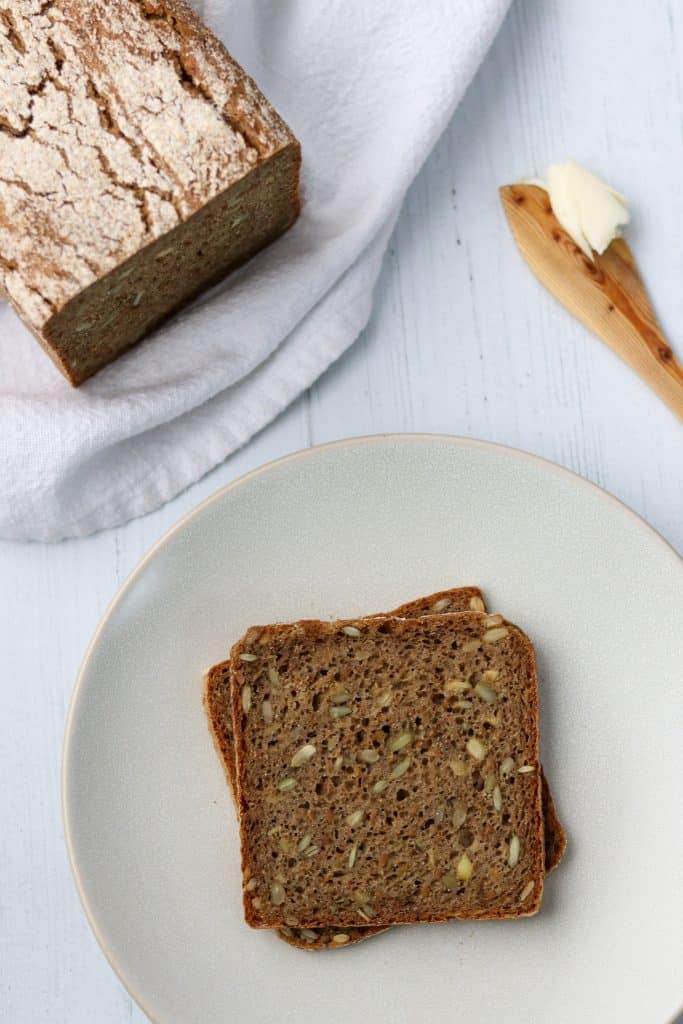
So...do you have a sourdough starter bubbling away on your countertop yet? Many of you must because I've had several recent requests for a sourdough version of rugbrød, the dense Danish rye bread that is often used as the base for smørrebrød. So I figured it was probably time to get this recipe up on the blog!
I've been making this sourdough rugbrød for several years now, long before I created this easy overnight version that I posted on the blog last fall. At the time, I figured that a lot of people don't keep sourdough starters at home, and they might appreciate a version that relies on commercial yeast for leavening. But, there is something to be said for making the real thing with your very own sourdough starter. Not only is it satisfying to use wild yeast for leavening, it also creates a delicious bread with a subtle tang that you will only get through the sourdough process. Sourdough bread also lasts longer than bread leavened with commercial yeast thanks to its acidic nature. So let's get started with the basics, shall we?
WHAT IS RUGBRØD?
Rugbrød simply means “rye bread” in Danish. It is a sturdy, dense loaf that is comprised of rye flour, chopped rye grains and is often studded with sunflower, pumpkin and/or flax seeds. It is almost always baked in a 13 x 4 inch pullman pan with a lid. This helps the rye bread bake properly and gives it its characteristic square shape.
Rye breads, particularly those baked here in America, often have a variety of ingredients added to them to enhance their color (making them darker in appearance) and flavor. Common additions include caramel coloring (no thank you), stout beer, cocoa powder, espresso powder and molasses. Rugbrød, in contrast, has very little additional flavoring, perhaps just a little molasses for sweetening. It is meant to be a very straightforward bread so that it can serve as a neutral base for a variety of different sandwich toppings. Sometimes I will come across a rugbrød recipe that calls for flavor enhancers such as caraway, fennel or anise seed in the dough, but this seems to be more of an exception than the rule. Again, simple is the name of the game here.
When it is served, Rugbrød is typically sliced thin (a little less than a quarter of an inch) and buttered liberally with salted butter. There is actually a word in Danish, tandsmør, which means “tooth butter”. It refers to buttering your bread generously enough so that when you bite into it you can see your teeth marks in it. You butter lovers know what I’m talking about. It may be enjoyed as is, simply slathered with butter, or it can be piled with additional ingredients to form the base of smørrebrød, the famous Danish open sandwich.
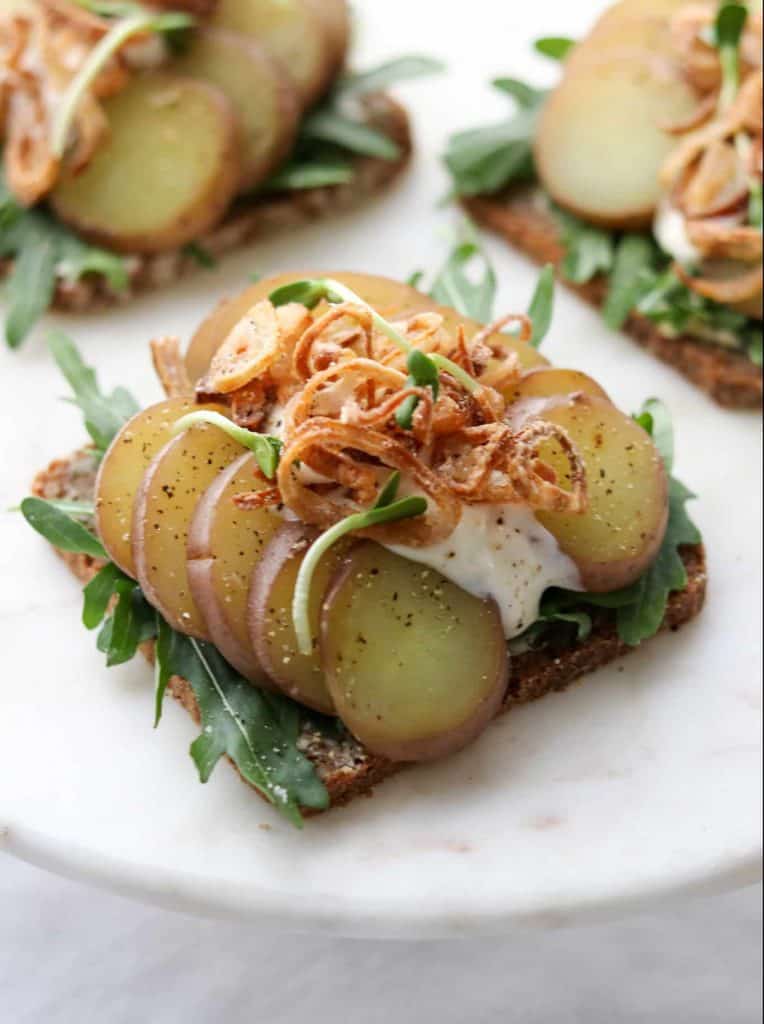
WHAT MAKES RYE SO SPECIAL?
Rye has many unique qualities that make it quite different from wheat, both as a whole grain and in flour form:
- Rye has historically been important for the Nordic region as it is a hearty plant that can tolerate poor soil and weathers cold and wet conditions better than most grains. It was the primary grain relied upon for bread-baking in the north for centuries and is still popular today.
- Rye flour has less gluten than wheat flour. Gluten strands form the structure of bread and trap gases produced by the yeast so that your bread leavens properly. Because gluten doesn’t form well when rye flour is mixed with water, rye breads are always more dense in structure and have a closer crumb that wheat breads.
- Rye flour holds more water than wheat flour and contains certain enzymes that convert starch to sugar. This can cause rye breads to be overly moist and have a gummy texture if not handled and baked properly.
- Your sourdough starter will help your loaf of rye bread succeed. While rye's unique qualities can make it challenging to use in a bread recipe, your sourdough starter can help counteract some of those challenges. Using a sourdough starter contributes certain acids to the dough which help neutralize some of the negative effects of the enzymes that can cause the bread to have a gummy texture.
- Rye breads get better with a little age. Unlike wheat breads which are best eaten shortly after cooling, both the texture and flavor of rye bread improves after a rest of 24-36 hours.
- An interesting fact: There is a fungus called ergot that can attack rye plants causing the grains to become highly toxic to humans and trigger hallucinations if ingested. Some historians believe that ergot-infested rye was the cause of the hallucinations that led to the Salem witch trials in Massachusetts in 1692. Fortunately, modern industrialization has all but eliminated any risk of ergot-infected rye as any diseased grains are removed prior to processing.
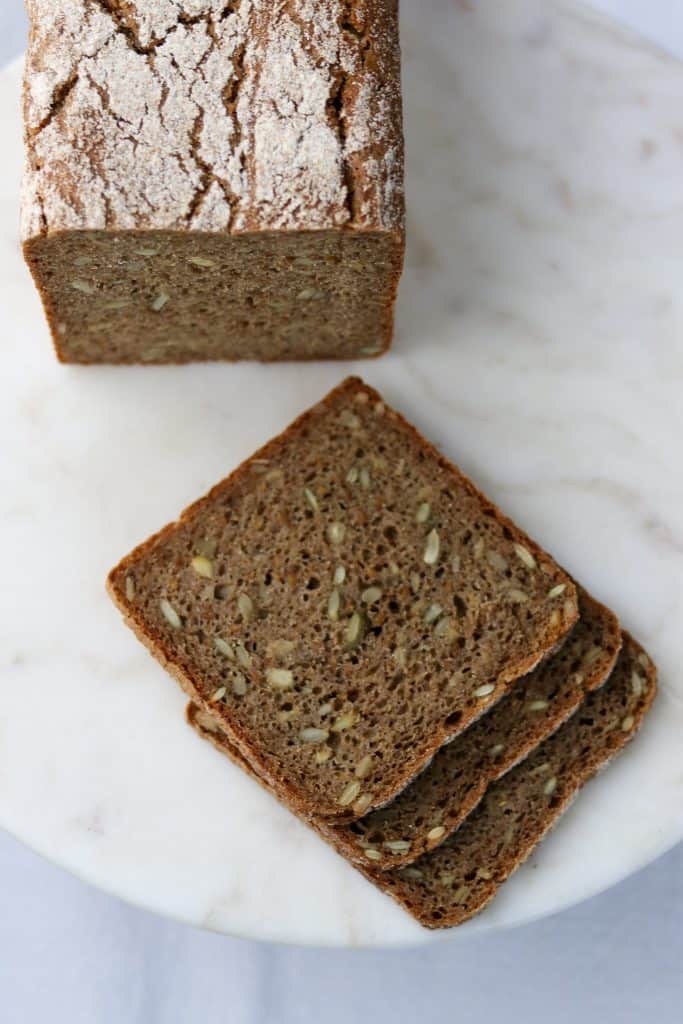
The Sourdough Process
Making sourdough rugbrød is really quite simple. Here is a quick overview of the process from start to finish:
Weighing Your Ingredients in Grams
The first thing you might notice about the recipe is that it is written in grams. Don't let that intimidate you. Most sourdough recipes are written by weight in grams and it is actually a really easy and accurate way to bake. Simply zero out your kitchen scale with the bowl you plan to use sitting on top. Set the scale to grams and start weighing! Seriously....easier than cups and spoons. Just remember to zero out your scale every time you add a new ingredient.
The Day Before You Bake: Refresh Your Starter
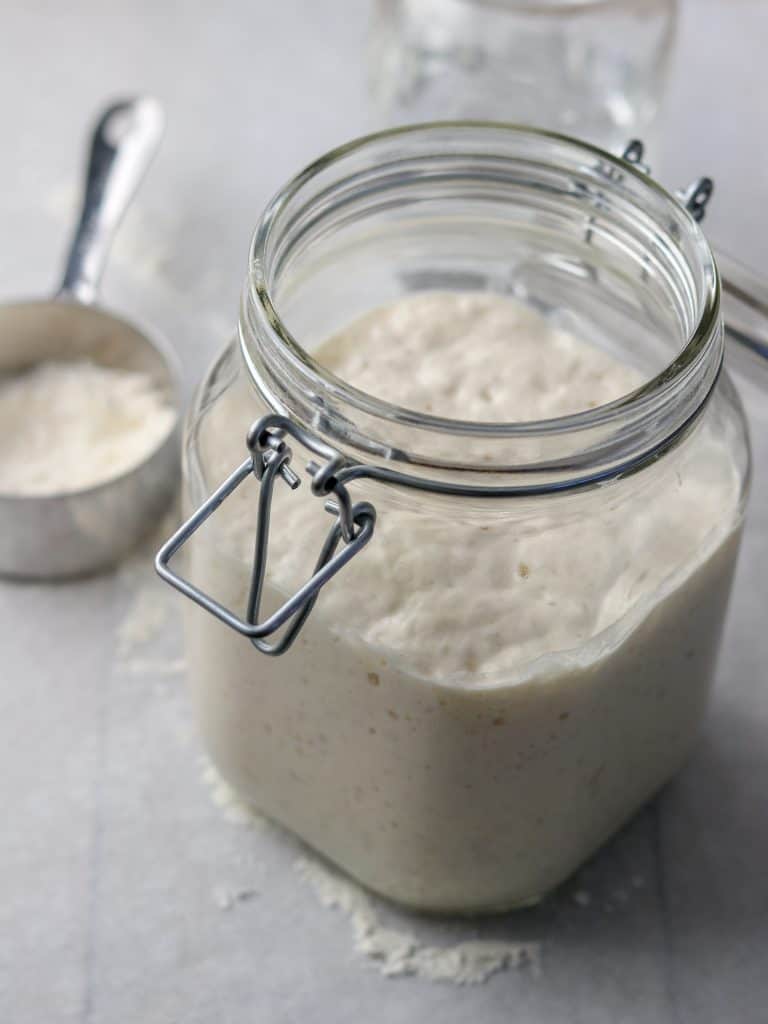
It's best to a use refreshed and ripe sourdough starter when you begin to build your dough. What does "refreshed and ripe" mean? Simply that you fed your starter about 8 hour prior to when you plan to use it. It should be bubbly, active and puffy throughout.
The Night Before You Bake: Create a Levain
This recipe calls for a levain, which is a term for a portion of the dough that will ferment overnight before we mix the final dough. A levain consists of water, flour and a bit of ripe sourdough starter.
The Night Before You Bake: Create a Soaker
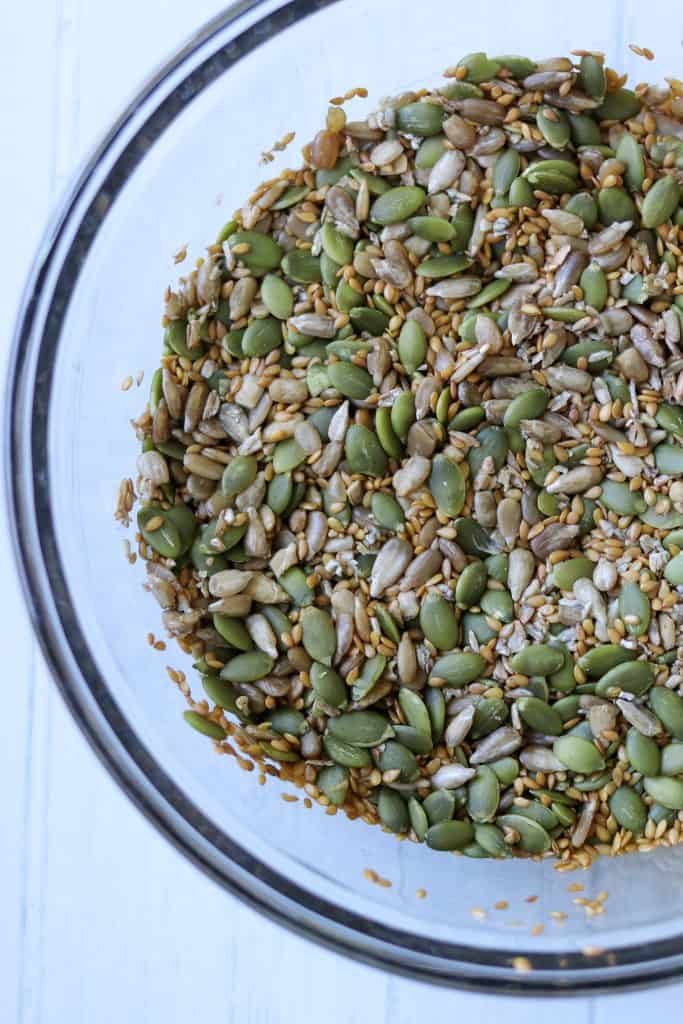
This recipe also calls for a soaker. This is a mixture of rye chops (or Bob's Red Mill 7 Grain Hot Cereal Mix) and seeds that will sit overnight in water prior to adding it to the final dough. Soaking these ingredients overnight in water helps soften them so that they will have a pleasant texture in the final loaf. And there is no need to drain the soaker prior to adding it to the final dough.
The Next Morning: Build Your Final Dough
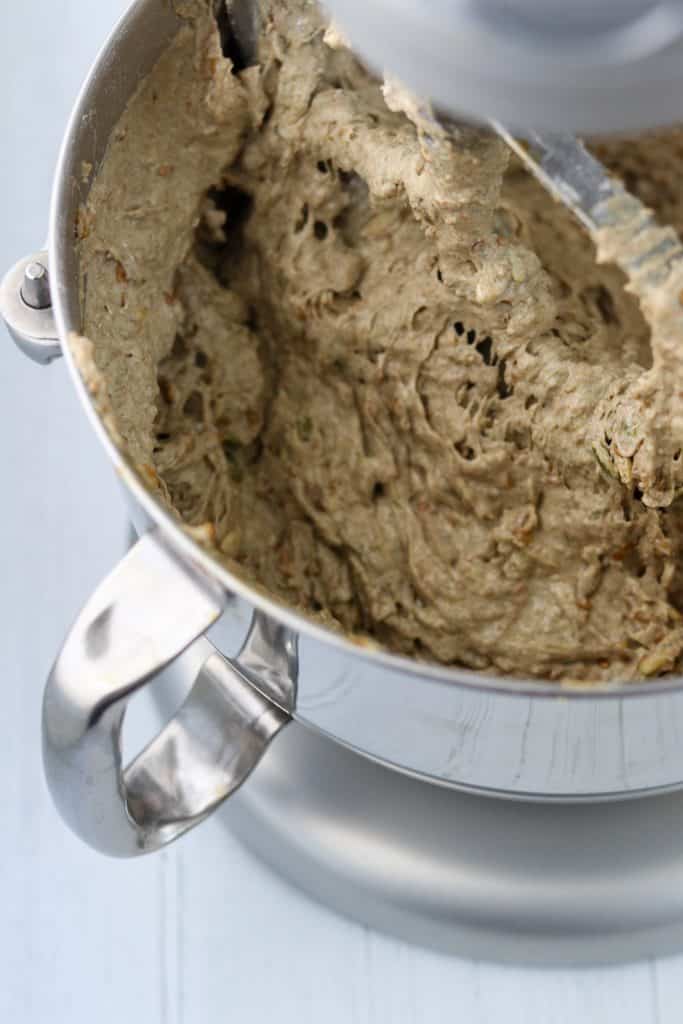
Your levain and soaker have been sitting overnight and it's time to put the final dough together. This couldn't be easier. Simply add all the ingredients for the dough to the bowl of a heavy duty stand mixer. Mix on low for a few minutes and then increase the speed to medium for a few minutes, scraping down the sides of the bowl occasionally. That's it! There is no kneading of this dough by hand as it is far too sticky to do so.
The Rise
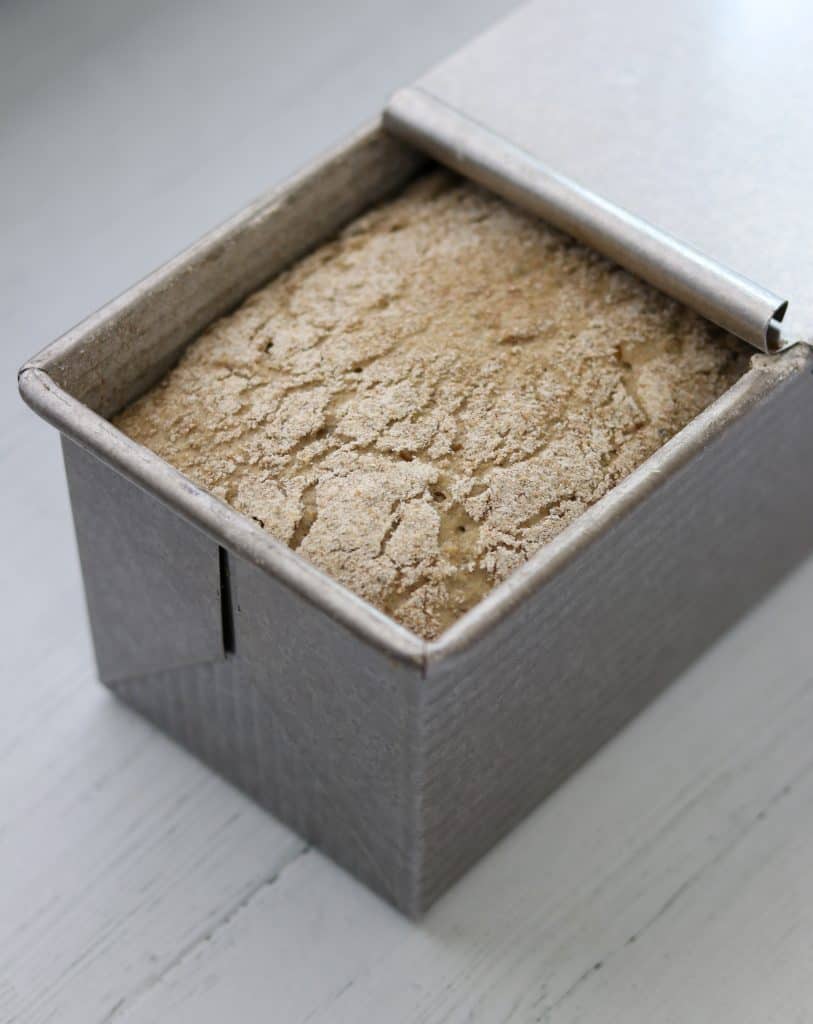
From here we scrape the dough into a greased and floured 13 x 4 pullman loaf pan with a lid. And then we wait. We let the dough rise and do its thing while we attend to whatever it is that we need to do. The dough should come within ½ inch of the top of the pan before we pop it in the oven. This will take anywhere from 1 ½ hours to 4 hours depending on the temperature of the dough and the temperature of your kitchen. Be patient and move your dough to a warmer spot if you want to speed things up a little. I will often turn the oven on and then let the pan sit on top of the stove while the oven preheats.
The Bake
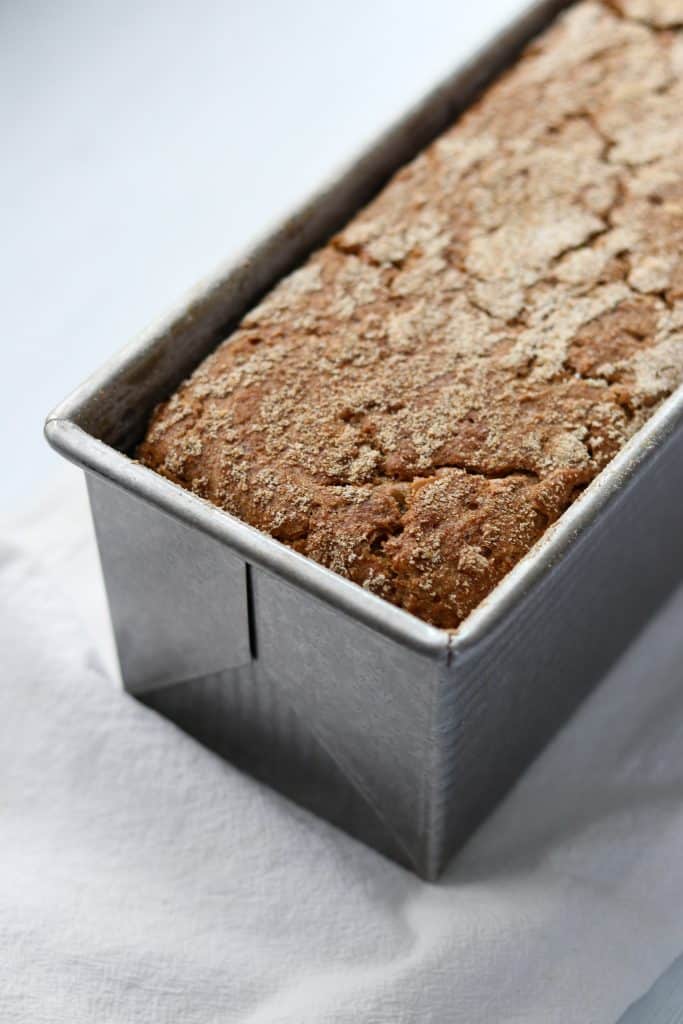
So what's up with the different baking temperatures in this recipe? They really do have a purpose, I promise. This method of baking helps prevent the enzymes that produce a gummy texture in rye breads from developing by keeping the loaf from spending too much time in the temperature zone where enzyme formation is the most favorable. The texture of your your bread will be moist and cooked evenly all the way through....just like you want it to be!
If you make your own smørrebrød at home or would like to, please give this sourdough rugbrød a try. It is one of the most delicious and nutritious breads out there and a great way to dip your toe into the world of sourdough. And using it as a base for a Nordic open sandwich will give you a true taste of authenticity. If you are new to smørrebrød, there are several open sandwich recipes on the blog to get you started:
- New Potato Smørrebrød with Garlic Aioli and Crispy Shallots
- Roasted Beet Hummus Smørrebrød with Avocado and Pickled Onions
- Roasted Broccoli Smørrebrød with Whipped Ricotta
- Roast Beef Smørrebrød with Remoulade and Crispy Shallots
- Italian Salad and Ham Smørrebrød
- Balsamic-Glazed Mushroom Smørrebrød with Garlicky White Bean Puree (vegan)
- Easy Garden Tomato Smørrebrød
- Chickpea Salad Smørrebrød
- Caramelized Leek and Snap Pea Salad Smørrebrød
- Smoked Salmon and Fennel Salad Smørrebrød
- Roasted Salmon Smørrebrød with Creamy Mustard Dill Sauce and Pickled Beets
- Beet and Celery Root Cake Smørrebrød with Herbed Skyr Sauce
- Roasted Butternut Squash Smørrebrød with Spicy Harissa Mayo and Pepitas
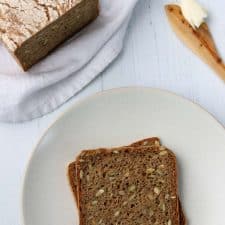
Sourdough Danish Rye Bread (Rugbrød)
Ingredients
Special Equipment Needed:
Ingredients for the Night Before:
For the Levain:
- 300 grams dark rye flour
- 100 grams bread flour
- 350 grams water
- 70 grams ripe sourdough starter
For the Soaker:
- 75 grams rye chops or 7 grain hot cereal such as Bob’s Red Mill
- 1 cup raw sunflower seeds (131 grams)
- 1 cup raw pumpkin seeds (142 grams)
- ½ cup flax seeds (65 grams)
- 285 grams water
Ingredients for the Day of Baking:
- All of the Levain
- All of the Soaker
- 200 grams dark rye flour
- 130 grams bread flour
- 180 grams water
- 18 grams salt
- 2 tablespoons molasses
Instructions
- The night before, make the Levain and the Soaker: Combine the ingredients for the Levain in a medium bowl. Stir with a spoon to combine (mixture will be thick and the texture of wet cement). Cover with plastic wrap and leave at room temperature overnight, approximately 12 hours. Combine the ingredients for the Soaker in a small bowl. Cover with plastic wrap and leave at room temperature overnight, approximately 12 hours.
- The next morning, grease a 13 x 4 inch pullman loaf pan (with a lid) and dust it with rye flour. Set aside.
- Combine the Levain and the Soaker (no need to drain) in the bowl of a heavy duty stand mixer. Add remaining dough ingredients. Using the paddle attachment, mix on low speed for 3-4 minutes, scraping down the sides of the bowl occasionally. Increase speed to medium and continue to mix and periodically scrape down the sides of the bowl for another 4 minutes.
- Using a sturdy spoon or spatula, transfer the dough to the prepared loaf pan, distributing it evenly across the length of the pan and smoothing out the top with a rubber spatula (if you are having trouble smoothing out the top, dampen the spatula slightly with water). Dust the surface of the loaf generously with rye flour. Put the cover on the loaf pan and let it rise until it comes to within a ½ inch of the top of the pan. This may take anywhere from 1 ½-4 hours depending on the temperature of your kitchen and the dough.
- Meanwhile, preheat the oven to 500 degrees. Place the covered loaf pan in the oven and bake for 15 minutes. Reduce the temperature of the oven to 400 degrees. Bake, covered, for an additional 15 minutes. Pull the loaf pan from the oven and remove the lid. Reduce the temperature of the oven to 325 degrees and continue to bake, uncovered, for an additional 45 minutes. Remove loaf from the oven and tip out onto a wire cooling rack. Let cool completely before slicing. Rye breads improve after a bit of resting time. If you can wait until the following day to slice into it, wrap the completely cooled loaf loosely in foil and let it cure until the next day. The bread will keep for about 4 or 5 days at room temperature wrapped loosely in plastic wrap and a layer of foil. For longer storage, wrap tightly and freeze.


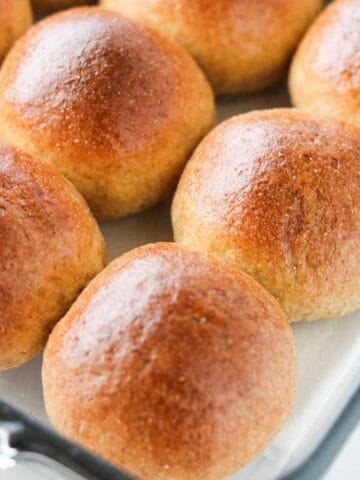
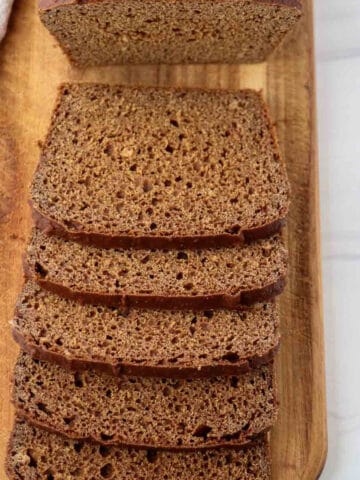

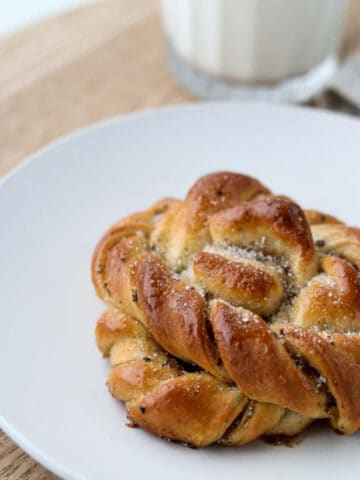
Jason
I’ve been a quarantine baker, and tried this recipe after trying several other rye breads. I used wheat flour instead of white, and cracked rye instead of rye chops.
The result was delicious and soft, but still a bit “gummy” throughout the crumb. Does this happen during the proof/riseor bake? I had to proof mine a bit longer in the oven with a warm bowl of water to get enough rise. Also, I found my oven to be pretty slow to reduce temperatures. When i shifted from 500 to 400 degrees, it was still at 425 after 15 mins when I shifted down to 325.
Thanks again for sharing!
Kristi
Hi Jason,
I'm so glad you've taken this quarantine time to up your rye baking game! I think the problem you are having is with using wheat flour rather than white. As you have probably learned over the last few weeks, rye can be very challenging to bake with! Adding regular white bread flour helps create a strong gluten network that helps keep a rye loaf from getting that gummy quality. Whole wheat flour also contains a fair amount of gluten, BUT if you put it under a microscope, you would notice that the flour has an almost razor-like sharpness to it. That's because it is ground from the whole kernel of wheat and isn't as 'soft" as white flour. This sharpness makes it difficult to create a strong and supportive gluten network because the gluten strands are continuously being cut by the ground but still sharp whole wheat flour. That's why 100% whole wheat breads have a tendency to be dense in texture. SO long story short.....if you switch the whole wheat flour to white, you should eliminate your gumminess problem. This is definitely a moist loaf, but it shouldn't be gummy. I hope this helps troubleshoot your situation! Happy baking! Kristi
Maria
I usually add wheat gluten to whole wheat bread to make them less dense. Would that solve the problem of a gummy bread?
Kristi
Hi Maria,
I have never had this recipe turn out gummy, but yes, wheat gluten can help provide structure to rye breads and help with their tendency to have a gummy texture. Hope this helps!
Kristi
Tikva Seinfeld
Thank you! Can these be made into rolls?
Kristi
Hi Tikva,
Thanks for your question! I think you could but you would need to bake them in a muffin tin or something along those lines (because the dough is very wet, you can't shape it like a traditional bread dough for rolls). And I would adjust the baking time as they will bake more quickly than a whole loaf.
Kristi
Jenna
Is it best to use a rye starter for this, or will my whole wheat starter do?
Kristi
Hi Jenna! Any starter will be just fine. I use a white bread flour starter. Happy baking! Kristi
Jean Gong
I am about to try your recipe but wanted to confirm your instruction to combine the soaker and levain in step 3. Do you mean to combine the entire contents of the soaker? This would include the original 285 grams soaking water or do I drain the soaker to get rid of excess liquid from the grains and seeds.
Kristi
Hi Jean! Include the whole thing. No draining. Let me know how it turns out!
Anita
I’d like to try this loaf but don’t have a Pullman Tin to bake it in, could I do a round or oval loaf?
Thanks
Kristi
Hi Anita,
The dough is really sticky and definitely needs a pan to bake it in. You could try using two regular 9 x 5 loaf pans rather than the Pullman pan and then use a baking sheet as a “lid” over the loaves while they need to be covered during the baking process. I haven’t tried this but other readers have had success with that method using the Easy Overnight Danish Rye recipe. I hope this helps! Happy baking!
Kristi
JOCELYN MAULDIN
If baking in a 9x5 would you change the temperatures or duration at each? Its hard because you need to leave the lid on to gauge what's going on with the dough.
Kristi
Hi Jocelyn,
I would keep the time and temperature the same. I've had other bakers tell me that has worked just fine for them. Please report back and let me know how it turns out!
Kristi
Sarah Grant
OMG this recipe is the bomb. I was always so daunted by other recipes and the time they took to make. This was so easy and foolproof and I loved how you broke the recipe down. This literally was a 24 hour bake for me from time of soaking to out the oven. Am going to make my second loaf soon, Like you say it just gets better with age.
Kristi
Hi Sarah,
I'm so glad you enjoyed the bread! I agree...rugbrød can be intimidating and I've had plenty of fails over the years as I tried to find a recipe that works. Thanks so much for taking the time to leaving me a comment. I really appreciate it!
Kristi
Roi
Hi Krisiti!
I don't live in the US, and I'm not sure how to source the stuff for the soaker. Is it possible to substitute the rye chops by blitzing whole rye grains in the food processor? should I just use different seeds/nuts? just omit it entirely?
Thanks.
Kristi
Hi Roi,
Thanks for your question! I think you could definitely try using whole rye grains that have been broken up in the food processor. For a little extra assurance that they will soften you could always use hot water to start the soaker. That might be worth doing. As far as the seeds go, you can absolutely eliminate them from the formula. That's actually how the recipe was originally written. If you choose to go that route, reduce the amount of water in the soaker to 150 grams. Please let me know how it goes and if you have any further questions. Happy baking!
Kristi
Roi
It turned out quit well!
I ended up needing to brake the rye berries on a mortar instead of the food processor. I hope that with further attempts I can make it even better 🙂
Thank you very much for the recipe and reply,
Kristi
Hi Roi,
So glad to hear it went well! Those rye berries must be tough...I really thought the food processor would do the job! Good thinking with the mortar and pestle. Please keep in touch as you continue baking and thank you so much for the feedback! It is very much appreciated.
Kristi
Richard
Hi Kristi,
Love the look of the recipe and definitely going to give it a try.
Just wondering about eliminating the seeds as my wife has a nut and sesame allergy and all the seeds are processed in the same factories so need to avoid. If still using the rye chops do I add extra or just eliminate the seeds and what water would you suggest?
Kristi
Hi Richard,
Thanks for your question! If you choose to eliminate the seeds, reduce the amount of water in the soaker to 150 grams. Everything else can remain the same. Hope you give it a try!
Kristi
Rob
This is such a good recipe. My first attempt at rugbrøt and it was a huge success. Thanks! One question: I didn't have any rye berries so I just used whole spelt and whole barley grain in the soaker. Bread turned out just fine so I was wondering what benefit younger from cracking the berries?
Kristi
Hi Rob,
So glad you enjoyed the bread! The general reason for using cracked grains rather than whole is to help them soften more thoroughly and assimilate better into the bread. Sometimes if you are using whole grains in a bread dough, they can be too hard in the final product, especially the grains around the outside of the loaf. I'm so glad to hear that this wasn't a problem! Thanks so much for your feedback! I really appreciate you taking the time to let me know how it turned out. Happy baking!
Kristi
Jim
Hello Kristi, thank you for this fantastic recipe! After an oven disaster with a different rugbrød recipe in May, I’ve been searching and evaluating others, and yours seemed like the best option for me. I had to make a few adjustments for scale, but the results were perfect.
I have two 4x9 Pullman pans, not a 4x13, so I did some math to scale up the recipe. Whether calculating in square inches or cubic inches, the multiplication factor was 1.38, so I multiplied all the ingredients by that amount. I also weighed the nuts so I’d have that for reference.
I subbed coarse rye meal for rye chops, and I think they are pretty equivalent. And I used a greased baking sheet as a lid, per your other tips. Everything worked out, filled the pans exactly, and created wonderful, tender rugbrød that we’ve just enjoyed for breakfast. Thank you again!
Kristi
Hi Jim,
I can relate to those rugbrød disasters! I've had more than my share. I'm SO glad you enjoyed the recipe and that it worked well, even with having to do a little baker's math. Thank you so much for taking the time to leave me a comment. I really appreciate the feedback. Enjoy those rugbrød loaves!
Kristi
Jillian
Hi Jim! How long did you bake the 4x9 loaves?
Kristi
Hi Jillian,
In case Jim doesn't get back to you, I recommend baking the smaller loaves for the same amount of time as the larger loaf. Hope this helps!
Kristi
Elizabeth
Hi Kristi,
I just found your site and this bread recipe looks fabulous! I would love to try it but I don't have all the ingredients on hand. Can I possibly sub oats for the pumpkin and sunflower seeds? Can I sub honey for the molasses?
Thank you!
Kristi
Hi Elizabeth!
Welcome and thanks for your question! You can omit the seeds entirely and reduce the amount of water in the soaker to 150 grams. And you can definitely sub honey for the molasses! Let me know how it turns out!
Kristi
Kristen
I am obsessed with this bread! I baked it for my Danish father and he now demands a loaf a week. I've swapped out half the seeds for hemp hearts and wheat germ, just for more variety, and it was still outstanding. It'll be fun to play around with. Thank you for a great recipe!
Kristi
Hi Kristen,
Thanks for your comment! I'm so glad you and your dad are enjoying the bread. I'll have to try it with a little hemp hearts and wheat germ! That sounds delicious! Please let me know if you come up with any other fun variations I should try. Happy baking!
Kristi
Colin Perkinson
quick question - why is there no true bulk ferment? many other recipes call for a short bulk, into pan, then overnight in the fridge. i've been using your method and i'm pretty happy with it, but wondering if it's turning out underfermented from a lack of a longer bulk ferment. thanks!
Kristi
Hi Colin,
Thanks for your comment! I use an overnight fermentation with any of my sourdough breads that have less than 30% rye flour. Jeffrey Hamelman's book, Bread sums up bulk fermentation for rye breads nicely: "Bulk fermentation time decreases as the rye percentage increases. One reason for this is that in rye breads there is little of the gas-trapping properties present in wheat gluten so lengthy bulk fermentation will not improve dough volume and crumb structure...Lengthy bulk fermentation has the tendency to overacidify the dough, resulting in bread with an unpleasantly sour flavor." Hope this helps! Happy baking!
Kristi
Amy
I have been married to a Dane for 26 years and have just made my first Danish sourdough rye using this recipe. I followed the recipe exactly as written and my loaf turned out perfectly!! Thank you!!!!
Kristi
Hi Amy,
Thanks so much for your comment! I'm so glad you liked the bread and that the recipe worked perfectly. Thanks again for taking the time to let me know. I really appreciate it. Happy baking!
Kristi
Sam
This bread is amazing!!! I baked yesterday and somehow managed to wait almost 24 hours to eat it 🙂 I made the following substitutions based on taste and materials on hand:
- 75 g. Bob’s Red Mill 10 grain hot cereal + 100 g water; no seeds in the soaker
- added 9 g Cocoa and 10 g. Caraway seeds
- 130 g. Rye flour in step 2 (that was all I had) and the rest in bread flour
My loaf pan can only go up to 450 degrees, so I baked as follows:
20 minutes @ 450
15 minutes @ 400
Took the lid off
55 minutes @ 325
Bread was slightly under baked; I probably should have just left it in longer at 325. The crumb is nice and regular, and the cereal I believe adds the nicest texture. With the caraway and cocoa it’s almost like a pumpernickel. Absolutely delicious and easy, thank you!!
Kristi
Hi Sam,
So glad to hear the bread worked out for you! Your variation with the cocoa and caraway sounds amazing and I bet it has a nice dark color, too. Thanks for taking the time to leave me some feedback! It is greatly appreciated. Enjoy the rest of that loaf!
Kristi
:D
Few questions: Can I use steel cut oats for thecracked rye?
Would sesame seeds be good for the sooker?
Can I use a 10"x5" loaf pan?
Other recipes uses Malt Syrup. Is molasses better and give the bread a darker color th han malt syrup?
Thank you!
Kristi
Hi,
I think steel cut oats might work just fine. I would give it a try. Sesame seeds will be good as long as you enjoy them. They are a little more flavorful that the other seeds in the mix, but that might be a good thing! You can use a smaller loaf pan. I have had several people use a standard sized pan and a sheet pan as a lid for the covered portion of the baking and they say it works just fine. Baking times remain the same. Malt syrup and molasses both work here. Molasses has a stronger flavor which works really nicely with the rye. It's also easier to find here in American grocery stores. Hope I answered your questions! Happy baking to you!
Kristi
:D
One last question: can I top the rye bread with additional seeds? Thanks again!
Kristi
You can! Maybe just keep an eye on them to make sure they aren't getting too dark in color. I'm guessing they will be fine as the cover is on while the oven is at its hottest.
Patricia Swanson
Hello again, Kristi,
After baking your regular Danish Rye Loaf about 6 times over the last months, I decided to give this sour dough style a try. I dutifully got the starter going and went for seven days. I HAD to bake on the 8th day. I followed the recipe exactly. On baking day, yesterday, I got the bread into the pan about 1 in the afternoon. At 5pm, the rise was minimal. I even turned the oven to warm a bit with the bread inside several times. Didn’t seem to matter. It was 5/8” from the rim, but I decided to bake it anyway. After the first 30 minutes when the lid comes off, the bread had reached the lid. I finished off the next 45 minutes, But, I decided to give it that five more minutes on a baking sheet out of the pan. It was pretty damp before that. Finally, just now, I tasted the bread. It had been out on the counter overnight. The top had a crack all along the top, which the regular rye recipe has never done. The inside was damp, but it cut nicely. The taste was definitely sour dough, which I love. So, I am calling it a success. One question-since I am baking only one loaf at a time about once a week, is there a good reason to keep such a large batch of the souring dough? Can I cut it back? Seems like such a waste of flour. Thanks, again, for your wonderful recipes.
Kristi
Hi Patricia,
How wonderful! Congratulations on your first sourdough! You can definitely cut back on it as long as you keep the ratios the same. And you can always put it in the fridge for a few days in between (so you don’t have to feed it on those days). Just be sure to take it out a day or two prior to baking to get it going again. And don’t forget to try making sourdough crispbread with that leftover starter! So good. The recipe is on my website. Thanks so much for the feedback!
Kristi
Patricia Swanson
I didn’t know you had a recipe for sour dough crisp bread. Wahoo! I have been making the regular ones weekly. I end up shaking with neighbors, so they go quickly. I will get right on it today!
Do you have a recipe for an overnight, no knead sour dough rye baked in a Dutch oven? If so, I would love the link.
Thanks many times over,
Patricia
Kristi
Let me know how it turns out! I don’t have any no knead recipes, but I will be on the look out for one for you.
Patricia Swanson
Hi Kristi, Grow, Forage, Cook, Ferment has a nice light rye recipe that I have now made about four times, it fits nicely in my 4 quart Dutch oven. I even increased it by 25% to get a little bigger loaf. I can now “flip” it pretty accurately out of the Brotform basket into the pan.
Kristi
Hi Patricia,
I will check it out! I hope that your starter is thriving and happy!
Kristi
Jim
Hi Kristi, here's an observation on my sourdough starter and proofing time that might be interesting for others. My one-year-old starter is whole-grain rye flour at 100% hydration (50/50 flour and water by weight) which I keep in the fridge and feed every 1-2 weeks for weekend bakes. It's rye based because I've delved deep into a lot of rye recipes.
I've made your rugbrød recipe twice, to great success (thanks again!). I feed my starter in early afternoon before making the levain at night, as per the recipe. We keep our thermostat at 71F year'round. The final rise in the pans has taken only an hour—which amazes me, since there is no instant-yeast spike involved! I don't know which of these factors help with the efficient rise, but it's a boon. I speculate that the balance of yeast/bacteria in a rye starter might be particularly good at blowing up a mostly-rye levain?
Kristi
Hi Jim,
That is really interesting! Thanks for sharing. I do notice that readers describe a wide variety of proofing times and I'm sure we are all working with different types of starters. Mine is a 100% hydration bread flour starter and my proof for rugbrød is anywhere from 1 1/2 to 3 hours depending on the temperature of the kitchen. I'm so glad you are still enjoying the rugbrød recipe. If you've got any suggestions for some other Scandinavian rye breads you would like to see on the blog, please let me know! I'm definitely looking to expand my repertoire in 2021.
Happy baking and thanks so much for the feedback!
Kristi
Jim
Oops, I need to correct myself. Checking my baking diary, it has taken no more than the low end of the range, 1.5 hours, to proof in the pans. I still find that to be really fast considering the dough is not getting any help from instant yeast.
Kristi
Agreed!
Kyle
6 stars. When I started baking more seriously at the beginning of the pandemic, this recipe seemed too complicated for me. Now, 6 months later, it turns out to be super easy to follow, you just need to start the night before. I bought a 4" x 4" x 6.5" Pullman just for this bread, so I make a half recipe. It has come out perfect every time so far. The 6th star comes because it made my European ex-pat neighbors cry, they hadn't had bread like this since last they went home.
Kristi
Kyle,
Thanks so much for your comment! I'm glad the bread has worked well for you, and that part about your neighbors really made my day. Thanks again for taking the time to leave me a note. It is greatly appreciated. Happy baking!
Kristi
VK
THANK YOU FOR THIS! It came out great except for some adventures with the baking containers. If I don't care about a perfectly square bread, could I make this with a regular loaf pan without a lid and put it in a dutch oven with a lid?
Kristi
Hi! If you want to use a regular loaf pan, split the bread dough between two 9 x 5 loaf pans or make a half recipe for one loaf pan. Use a metal baking sheet as a "cover" during the portion of the bake that is covered. All baking times and temperatures remain the same. Hope this helps!
Kristi
LaurenE
This was my first rugbrod and I was so nervous, but this felt easy in the end! Thank you for this excellent recipe! We had smorrebrod for NYE dinner and it was wonderful. Not gummy or heavy, just beautiful dense, almost mildly flavored but still rich rye bread!
- I used whole rye berries, because I couldn't find cracked rye and I couldn't seem to break them down with either a food processor or my mortar and pestle. Soaked about 13 hours and it was fine!
- I used a normal loaf pan and three mini loaf pans. Normal loaf pan - 10/10/35 minutes, and the mini loaf pans went 5/5/35 minutes at the above settings. I checked internal temp to 190 to confirm they were done.
Kristi
That's so great, Lauren! Thanks for your feedback. I love the idea of smørrebrød for New Year's. So perfect! Happy New Year to you!
Kristi
Judy
Hi Kristi, I made this rugbrød for the first time; I had been looking for a good recipe since our last visit to Denmark last summer. I have always loved the Danish bread and now was the time to bake one myself 🙂 and your recipe sounded good!
I adjusted it a little because I don’t have the size pan you mentioned. I actually used an old Corningware baking dish and fabricated a lid out of tin foil as the glass lid seemed to be a bit too low to allow for expansion. I used coconut oil to grease the dish thoroughly. My bread needed a proofing of 4 hours for perfection. The baking was interesting compared to a regular sourdough bread. But worked great! The bread came out just perfect, slightly moist, beautiful texture, great taste and crunchy crust. Delectable! My husband is also very happy 🙂
Thank you for sharing!!
Laurie
Thank you for the recipe. My loaf turned out wonderfully. I followed the recipe exactly the only difference being my pan which was a 13 x 5” Emile Henri large loaf pan with a domed cover. I was surprised by the moisture of the dough but having read all the comments and instructions I thought it fit what everyone it said. The bread is super tasty. Thank you again
Kristi
Hi Laurie,
Thanks for your feedback! I'm so glad you enjoyed the bread. Happy baking!
Kristi
gabriela bayardo
Hi Kristi!
This was my third time making this bread and on this last try it turned out gummy. I did not see much rise. I followed your recipe as the other two previous time but this time I did use the mixer to mix for three and then four minutes. It's the only thing that I remember doing differently. Any idea why it turned out gummy? Does the mixing impact the rise?
Thank you!
Gabriela
Kristi
Hi Gabriela,
That is strange! I definitely could be the mixing time. The mixing activates the gluten in the wheat flour which provides the structure for the bread. Without a strong gluten network, the gumminess is a possibility. Hopefully this is helpful! Please report back after you give it another try.
Kristi
Rick
Hello,
Thank you for this informative post. I have been playing with Rugbrod for a couple of months now, and had reasonable success. I have a great rye starter that is going like gang-busters. My only question is the rugbrod I had in Denmark was much darker than what I am producing. I have heard that true rugbrod is actually baked at a very low temperature (250 degrees F) for 12-14 hours fully covered for the entire time and it is that process that creates the dark color. Have you ever tried this?
Kristi
Hi Rick,
Thanks for your comment! I have not tried that method, but I can see how that might produce a darker colored bread. I also wonder if it has something to do with the type of rye flour available here in the US vs. in Denmark. My rugbrød is always a medium brown color rather than a a dark brown. Please keep in touch and let me know if you try a new technique that produces a darker loaf!
Kristi
Susannah Gauntlett
Hello Kristi
I live in England & have always wanted to bake homemade Rugbrød so decided to try during lockdown. I researched recipes & chose yours, & have bought everything you suggested. You wrote in your recipe for the American's that measuring in grams is easier than using cups. Well imagine my frustration when 3 of your ingredients for the Soaker (sunflower, pumpkin & flax seeds) are all measured in cups! So I looked up on the web to find out how many grams are in a US cup & found the Pinterest site, & to my horror its different every time! depending on the ingredient. PLEASE can you tell me how many grams of Sunflower, Pumpkin & Flax seeds I should use in your recipe? As I am ready, & excited to bake my first Rugbrød! Thank you Susannah
Kristi
Hi Susannah!
Thanks for your question! I did the measurements for you this morning:
65 grams flax seeds
142 grams pumpkin seeds
131 grams sunflower seeds
I will add those to the recipe card as well. Hope this helps! Happy baking!
Kristi
Franca
Hi, would love to make this bread, it looks absolutely delicious. Can I substitute the 7 grain hot cereal mix for the 10 grain hot cereal mix? As I can’t seem to find the 7 grain.
Kristi
Hi Franca,
Yes, that should be fine! The 7 grain cereal has been hard to find recently. Let me know how it turns out!
Kristi
Franca
Thank you
Fiona
Hi, I have 4 questions:
I have a steam oven. Does this mean that it is unnecessary to cover the baking bread with a lid?
Does this recipe work with 100% sprouted rye flour, rather than with the additional bread flour mentioned?
Are rye chops the same thing as cracked rye grains?
Does it really make a difference which percentage 100% or 166% starter/levain mix used?
Thanks!
Kristi
Hi Fiona,
Thanks for your questions!
1. Yes, you should still cover the pan if you have a steam oven. You won't get the characteristic square shape without covering the pan.
2. I've never tried this bread with all rye flour so I'm not sure. As you are probably aware, 100% rye loaves can be tricky. Please let me know if you give it a try! I would love to hear if it works out.
3. Yes, rye chops and chopped rye grains are the same thing.
4. I use a 100% hydration starter but I think %166 would be fine, too.
Hope this helps! Happy baking!
Kristi
Matt
I just want to say thank you because this recipe is amazing. My partner and I had a wonderful week pre covid in Copenhagen. During lockdown I was given sourdough starter and gave this recipe a try.
I make it every two weeks, freezing half of the loaf. Every morning for breakfast I have a soft boiled egg and some smoked salmon on top of a slice of this wonderful bread. Thank you.
Kristi
HI Matt,
Thanks for your kind note! I'm so glad you are enjoying the bread and that it has become a part of your regular baking rotation. And I love your breakfast idea! I'm totally trying that. Thanks for taking the time to leave me a review! It is much appreciated.
Kristi
Nina
Hi,
I made your Rugbrôd bread with great success, but mine rose all the way to the top of the Pullman and then oozed out during baking making a very angular loaf! When I cut into it there was a long hole, in the middle, running almost the whole length of the loaf. Do you think I let it rise too long or perhaps I should find a cooler spot? It rose quite quickly just barely an hour, or should I run a knife through it first next time?
Thanks,
Nina
Kristi
Hi Nina,
I think your instincts are correct....maybe both a shorter rise and a cooler spot. I've made this bread more times than I can count, and I did have something similar happen once on a particularly warm day. Please let me know if you try it again and what happens! Hopefully you were still able to enjoy the bread even if it didn't look perfect!
Kristi
George
https://i.vgy.me/6KzqMu.jpg
Tremendous recipe. I'm making another loaf now with steel cut oats instead of the 7 grain cereal. I'm also using Maple syrup instead of the molasses. I'll let you know how it turns out.
Kristi
Hi George!
Thanks for the feedback! So glad you enjoy the bread. I hope the experimenting turned out well. Steel cut oats and maple syrup sound like a good combination!
Kristi
Tari van Collem
Thank you for the recipe.
I made this two days ago and ate 2 slices for breakfast this morning. So good…
I didn’t have rye kernel in my pantry so I replaced with barley. I let the loaf proof overnight instead pf 4 hours.
Definitely will use the recipe again.
Tari
Kristi
Hi Tari,
Thanks so much for your comment! So glad you enjoyed the bread and that barley worked as a substitute. Happy baking!
Kristi
Rachel
Turned out delicious! I made a couple adjustments: I didn’t have a Pullman pan so I used a 9x5 bread pan lined with a tall rim of parchment to prevent spillover with the rise. That worked great. It has a rounded top but taste and crumb were great and didn’t over brown even through it was uncovered the entire bake time. I may have baked a bit longer; I baked to internal temp of 190. Also I used whole rye berries since that’s what I had. They were a bit chewier than I hoped for but not bad. Next time I will boil them briefly before adding the rest of the soaker ingredients. Very much a keeper!
Kristi
Hi Rachel,
So glad you enjoyed the bread and that the adjustments worked out fine. Thanks so much for taking the time to leave me a review!
Kristi
Rachel Dooney
Is it possible to bake this in a tin with no lid. I don't have a lidded Pullman tin? I have made sourdough bread before but want to try a new recipe. Can you suggest other alternatives to rye chops or the 7 grain bob mills. I'm in Ireland and these are not easy to find. Would pinhead oatmeal (steel cut oats) work?
Kristi
Hi Rachel,
Thanks for your question! Yes, you can bake this bread in two regular sized loaf pans and use a greased baking sheet as a "lid" for the portion of the bake time that it needs to be covered. I have never tried this recipe with steel cut oats but I seem to recall hearing from a reader who had and it worked out just fine. Hope this helps! Happy baking!
Kristi
Bryan
Great bread! Thanks for the recipe! I’m having a problem, though. I’ve just baked my second loaf and neither of them has risen as much as they should have. The first time, I put the pan in the oven with the light on. It raised to about 1.25 inches from the top of the pan. The second time, I put the pan in a small room with a portable heater keeping the temperature up and got pretty much the same result, maybe a .25” difference. What other things could I try to get more height? Put it in a steamy environment? Add more starter? Any ideas? Thanks!
Kristi
Hi Bryan,
Thanks for your feedback! I'm glad you are enjoying the bread. As far as your question goes, it sounds like you've already played around with the temperature during the rise. Have you tried giving it a longer rise time? If you have already tried that, I would suggest maybe adding a little more sourdough starter and see where that gets you. Please let me know if that is helpful!
Kristi
David
I'm eager to try this recipe and would like to know if all-purpose flour can be used in place of the bread flour. Will the lower protein content of all-purpose flour cause this recipe to fail? Many thanks for letting me know. I appreciate it and look forward to making this bread once I hear back from you.
Kristi
Hi David,
I have never tried it with AP flour but I think it's worth a shot. It is a pretty forgiving recipe. Let me know how it turns out!
Kristi
David
Hi Kristi,
Many thanks for the helpful advice. I made the bread with all-purpose flour, and it turned out great! I'm going to be adding this recipe to my regular lineup!
David
Kristi
YAY! I'm so glad. Thanks for getting back to me!
Kristi
Zdenka
Made this yesterday and managed not to try it until today. Really good. Very similar to ones that cost arm and a leg in shops. Used my sourdough. Also good toasted
Kristi
Hello,
Thank you for your comment! I'm so glad you enjoyed the bread and I agree....It's much more economical to make it at home!
Happy Baking,
Kristi
James
Hi Kristi, Fantastic recipe, works perfectly as written. I noticed that some people are having a problem finding rye chops. I find that my “Ninja” blender breaks whole rye berries up pretty well where my food processor will not. Not perfectly consistent, but just a few seconds seems to do the trick. Love your site. Cheers!
James
Kristi
Hi James,
Thanks for your feedback! I get that question a lot so I will pass it along. SO glad you enjoyed the bread. It's one of my favorites.
Happy Baking!
Kristi
Rosemarie Gilby
Hej Kristi!!
Mange tak!! You have made this Dane's wife SOOOOO happy!! Finally a recipe that 1)works, 2)tastes as good as/if not better than the store, and 3)I can serve with pride because I can cut it!! You don't know how many loaves I have tossed. I am so glad I tried yours, thank you!! Even made it Gluten-free (instead of Bread flour, used a mix of 1 1/2c oat flour, 1 1/2c potato flour, 1/2c chick pea flour, 1/2c almond flour, 1tsp ground flax) and it still worked perfectly. Doing a little dance before I have another slice
Kristi
Hi Rosemarie,
YAY! I'm so glad you enjoyed the bread AND were able to find a gluten-free alternative for the bread flour! I had the same experience with other rugbrød recipes....a lot of them ended up in the trash. Thank you for taking the time to leave me your feedback. It is much appreciated!
Happy Baking,
Kristi
Mavky
I had a 9 x 4" Pullman pan, so I reduced by a third. This might help anyone else who has the smaller pan. Thanks for the recipe! Just great.
levain:
200 grams dark rye flour
67 grams bread flour
231 grams water
46 grams starter
soaker:
50 grams Bob's Mill 7 Grain Cereal (I used 10 Grain)
86 grams sunflower seeds
93 grams pumpkin seeds
43 grams flax seeds
188 grams water
The Rest:
132 grams dark rye
86 grams bread flour
118 grams water
12 grams salt
1.3 tablespoons molasses
Kristi
Hi Mavky,
So glad you enjoyed the bread and thank you so much for that helpful feedback!
Kristi
Jodie V
This is a great recipe! I had never baked a rye bread before so it was a bit of an adventure for me.
It turns out the rye flour at my local store is light rye I guess, but the bread turned out perfectly even after incorrectly scaling the recipe back for a 4 x 10 tin and having to subsequently bake it without a lid.
I used pumpkin seeds, wheat grains and hemp seeds in my soak. I don't have a tin with a lid so my intention was to place another tin on top to act as a lid, however after barely an hour proofing, the dough had reached the top of the pan and I had to abandon that plan. I baked it using combi-steam to make up for the lack of lid, and let it sit wrapped in foil overnight.
My husband and I have just had a slice with salted butter for breakfast and it is delicious.
Thank you so much for the recipe!
Kristi
Hi Jodie,
Thanks for your comment! I'm so glad you enjoyed the bread. It's a great one for getting starting with rye recipes!
Kristi
I B
Hello Kristi, thank you for this recipe. Can't wait to try. Do you think this recipe will work without a heavy-duty stand mixer and mixing by hand?
Kristi
Hello,
Thanks for your question! I do think you can mix it by hand. It is super sticky and will require a bowl and wooden spoon (it's too sticky to knead by hand). And strong muscles, too!
Kristi
I B
Thank you 🙂
Walter
Can this be made without a stand mixer? I've baked many sourdough breads using no knead methods and do not own a stand mixer.
Kristi
Hi Walter,
Yes you can, it's just a really sticky dough so the mixer makes it easy. You can certainly use a spoon and some elbow grease to do the mixing instead! Hope this helps! It's a really great recipe. I hope you give it a try.
Kristi
Walter
Thanks I figured. I've made a Danish rye before no knead and the recipe was similar but with a longer ferment and it was a bit too sour for my liking.
Bobbie
We love the bread this recipe produces. I changed the soaker to suit our tastes: no pepitas, added more flax seeds, sesame seeds and some rye berries to the Bob's 7 grain cereal. I put the sunflower seeds in when mixing up the dough on day 2, because we like them a bit crunchier. Perfect!
Kristi
Hi Bobbie,
Thanks so much for your comment! I love how you've played around with the soaker to suit your own tastes.
Happy Baking!
Kristi
Scott Beethe
I have made a number of different Rugbrod recipes now some being failures and some being really great. I found this recipe to be among the best. For me, It has a perfect balance of moisture, chew, and flavor. It also toasts up well, deepening the flavor a bit. I did allow the overnight levain to go 15 hours instead of 12 giving a little more sourness which I like. I truly enjoy the sour, sweet, and salty balance it has but what change would you suggest to get a little more malt flavor in it? Add malt syrup? Use beer in place of water? other ideas? Thank you for this excellent recipe and all you and your readers' suggestions.
Kristi
Hi Scott,
Thanks for your comments and question! I like your idea about the malt syrup best. I think the beer might get lost with all of the other strongly flavored ingredients. Please let me know if you give it a try!
Kristi
Mo Higgs
Thank you so much Kristi, what a fabulous recipe! I have been making sourdough for the last five or six years but have always been a little nervous of rye bread. Your recipe has changed that. I followed your recipe, the only changes I made were to use steel cut oats instead of rye chops and I split the dough between 2 9x4 Pullman tins. They turned out perfectly, thank you so much! Now I’m going to bake the sourdough rye crisp breads, fortunately, I have discard in the fridge, I’m hooked. With love fruit m Cape Town, South Africa
Kristi
Hi Mo,
Thanks so much for your comment! I'm so glad the bread worked well for you. It is one of my favorite recipes and always comes out great. Enjoy the crispbread!
Kristi
David
Hi Kristi,
If I understand correctly, rugbrød is traditionally made exclusively from dark rye flour. Is it possible to make this recipe entirely with dark rye flour? If yes, would one simply substitute dark rye flour for all the bread flour, or do you recommend different measurements? And if no, why wouldn't using only dark rye flour work? Many thank for your guidance.
David
Kristi
Hi David,
Thanks for your question! Making a 100% rye bread is an entirely different kind of baking project, thanks to the fact that rye flour has very little gluten and contains certain types of enzymes that are activated during the baking process and can produce a gummy loaf if not handled properly. There is a good and reliable recipe for 100% Icelandic Rye Bread at the King Arthur Flour website that I've tried and had good results. I would suggest trying that as a starting point. Hope this is helpful!
Kristi
Sherry
For a 1 lb loaf (Pullman 8X4) would you cut the recipe in half and bakd for the same amount of time?
Kristi
Hi Sherry,
Yes, that's exactly what I would do. Happy baking!
Kristi
David
Hi Kristi,
Back on February 27, 2023, I wrote to ask if it's possible to make this rugbrød recipe entirely with dark rye flour, and you explained that making a 100% rye bread is an entirely different project because of rye flour's particular chemistry, which is what I had understood for years. Recently, though, I noticed that mass-produced, plastic-packaged German rye bread made by Mestemacher (sold at World Market, on Amazon, and elsewhere) is made from 100% rye and uses yeast, rather than baking powder and baking soda like the Icelandic Rye Bread recipe you suggested on King Arthur Flour's website. I also found some recipes for rugbrød in Danish online, and when I Google translated them, they appear to use sour dough starter and 100% rye, with no baking powder or baking soda. And so I'm wondering: Do you know how Mestemacher does it? Do you know how traditional old-fashioned Danish rugbrød recipes managed to work with 100% rye? I'm eager to hear your pearls of wisdom. Many thanks!
David
Kristi
Hi David,
I do not know their secrets, I am afraid! I do buy their bread sometimes and it's not bad :). It definitely can be done! I will keep my eyes out for recipes that be what you are looking for!
Kristi
David Agruss
Many thanks, Kristi! I'll keep my eye out as well for anything that reveals the secrets of bread made from 100% rye flour and sourdough starter. And if I find anything, I'll report back!
David
jean
Hello! I made this recipe last weekend (first ever attempt at rugbrod) and it produced delicious results. I had to substitute medium rye since I already had that on hand. Mine also rose pretty quickly and was trying to escape my pullman pan. I want to try this recipe again and adjust to my preferences. Do you know how I could create a crunchier crust? I would say my results this first time were a firm crust, but not crunchy. For reference, there's a Danish bakery here in NYC that sells a cranberry variation of rugbrod and it has the most amazing, crunchy and deeply toasted crust. Should I try baking at a higher temp for longer? Bake without the pullman lid at all? Should I try removing the entire loaf from the pan for the final bake? Any other recipe tweaks you suggest? Thank you for this great and easy recipe! Will be making weekly for the foreseeable future.
Kristi
Hi Jean,
Thanks for your comment! I think I would try removing it for more time during the final bake if you are after a crunchy crust. Let me know how it goes! I love the idea of adding cranberries to this recipe. Yum!
Kristi
Susan E Clarke
I'm very impressed with this recipe; it's still wonderful 48 hours after baking. For the sweetener, I substituted a dark brown sugar syrup from Germany ( Goldsaft) because I had it in the cupboard. Thanks again.
Kristi
Thanks so much for your comment, Susan! I'm so glad you enjoyed the bread.
Kristi
Richard
I have made several different recipe of rugbrod. This is hands down my favorite. My mother was Danish and I was raised eating this bread. Highly recommended recipe. It will easily adapt to addition of different seeds.
David
My problem using this recipe with the large Pullman loaf pan is that the oven spring results in the dough pushing up against the lid and oozing out at the corners. My starter is 100% hydration rye and seems very active as the dough gets to within a half inch of the top of the pan fairly quickly. Is it necessary to use the lid during the first stage of the bake? What problems would occur without using the lid? Also would it be a good idea to bake the loaf until it reaches an internal temperature of about 205F? It seems there can be a lot of variability in the accuracy of oven temps. Thanks so much.
Kristi
You could certainly try it without the lid but you don't use it, you won't get the nice square shape. My lid has a very tight fit and I've never had any problems with my bread dough oozing out the corners, even with an active rise.
Kirsten
I have now made two loaves. The first was too gummy even with extra 40 minutes at 325. I kept checking te internal temperature and found it stayed at 94 c the whole 40 minutes.
For the second loaf, I added 2 taps of Malt powder, I baked it last night at 500 c for 20 minutes, then 20 minutes at 400 c, then 1.30 hrs at 325 c. The internal temperature after that time got up to 96 c. This morning I cut a slice and it looks exactly like your picture! It tasted wonderful. It is still a bit wet, I guess there is nothing I can do to make it dryer.
Thank you, tak, Kristi!
Kristi
I wonder why that has been happening? But good trouble shooting on your part! Enjoy the bread!
Trish
I spent a couple of weeks in Denmark and Sweden in June/July and had rugbrod (topped with butter and lingonberry jam) every morning at the hotels. I missed it terribly when I got back home. The only place I could find in my area that sells it is a Danish bakery about 70 miles from here - a mere $23 a loaf. Plus shipping. No thanks. So I knew I'd have to make my own. I found this recipe and immediately ordered a Pullman pan and picked up a higher-end stand mixer (my basic model is fine with batters, but not so much with bread doughs), then went to town. No other recipe is needed - this one is absolutely perfect. It tastes exactly like the rugbrod I had in Scandinavia. I am thrilled! I been baking a loaf every five or six days now!
Kristi
Wow! That is fantastic! Thanks so much for your feedback. Sounds like you are saving yourself some money in the long run, even with the investment in a mixer and pan. 🙂
Michaela
I bake this delicious bread every two to three weeks. And have been for about a year and a half since I was directed to this recipe by my sister, who also gave me the Pullman pan. Almost always it comes out perfectly. Sometimes there is a bit of a hole in the center, mainly if it has risen too quickly I think.
I use a tabletop nut/coffee grinder to chop up the whole rye berries since that is all I can buy locally. And I use Bob’s Red Mill flaxseed meal. I also add a heaping tablespoon of honey.
I cut it by hand with bread knife into about 44 slices, then freeze smaller packages to take out when needed.
How do you slice this bread? Have you ever used the chop blade rugbrød slicer? My mother had one and I have been considering trying to use it.
I also am curious about the nutritional values included at the end of the recipe. How big a portion are the measurements for?
Thank you
Jane
Hi there! I'm new to this - have made 4 sourdough rye loaves using a "beginner friendly" recipe and they came out really well taste wise! I'm here because my big problem was the loaves sticking to my non stick pans despite greasing well, coating with flour etc. I even used a partial lining with parchment altho my recipe cautioned against a full lining because of possible sogginess, and suggested a sling. Despite careful greasing and flour coating of the exposed corners, it stuck. I have now destroyed the non stick coating of those pans in my efforts to get them out so I arrived here looking for recommendations for quality pans. You've sold me on your recipe too! The whole lid thing seems like it will improve my bread. So I just need to purchase tins! I really don't want non stick as thousands of reviews on quality pans suggest non stick does not hold up well when baking sourdough. What about cast iron? Or do you have any other recommendations? Thanks so much for your recipe!
Kristi
Hi Jane,
I have only every used the nonstick pullman pan from USA pans for this recipe so I'm not sure how other pans would perform. For what it is worth, I love my USA pan and actually have two of them!
Kristi
Jane
PS Can I leave out the rye chops and hot grain cereal as I have no idea where I would source those items in a small Australian town!
Kristi
Could you find steel cut oats? I have had other people use those instead of the rye chops or hot grain cereal with good results.
Hester Reik
Fantastic recipe. Just tried this today. superb. I made a mistake, thinking I'd turned down to 325, when I didn't. Caught the error after 30 minutes, and took it out 10 minutes early. Still delicious. Marvelous
Kristi
Hi Hester,
So glad you enjoyed the bread! It's such a great recipe. Thanks so much for taking the time to leave a comment. I very much appreciate it!
Kristi
Hester Reik
It is an amazing recipe, actually. I made it again today (remembered to turn the oven down) and it's just spectacular. I do have one question. When you are calculating how much salt to use do you consider the grains and seeds like flour. Usually i do 1.5 - 2% salt by weight of flour. Thanks in advance
Kristi
Hi Hester,
For this recipe I started with one from Richard Miscovich's book "From the Woodfired Oven" so I didn't do any of the calculating myself. Sorry I'm not more help!
Kristi
Rachel
I commented quite a while ago, but had to leave an update. This recipe is absolutely worth the purchase of a Pullman pan, and I hate buying single use kitchen tools. This bread has become our house staple whenever I’m in a sourdough baking “phase.” I always use whole rye berries and pour boiling water over the soaker. The berries have never come out too chewy. Perfect for a variety of open- faced sandwiches. Even my 2 year old loves it.
Kristi
Rachel,
Thanks so much for your update! I'm so glad this lovely bread has made it into your baking rotation and that it is enjoyed by the whole family. It is definitely one of our favorites around here, too!
Happy baking!
Kristi
Richard H Seaton
My family and i love this recipe. I have baked a bunch of different RogBrod recipes. This is hands down the best recipe. Easy to follow. Results are always great. It seem just like the RogBrod my Danish MorMor made. Thank You for the great recipe.
Kristi
Hi Richard,
Thanks so much for the nice comment! I"m so glad you and your family are enjoying the bread.
Kristi